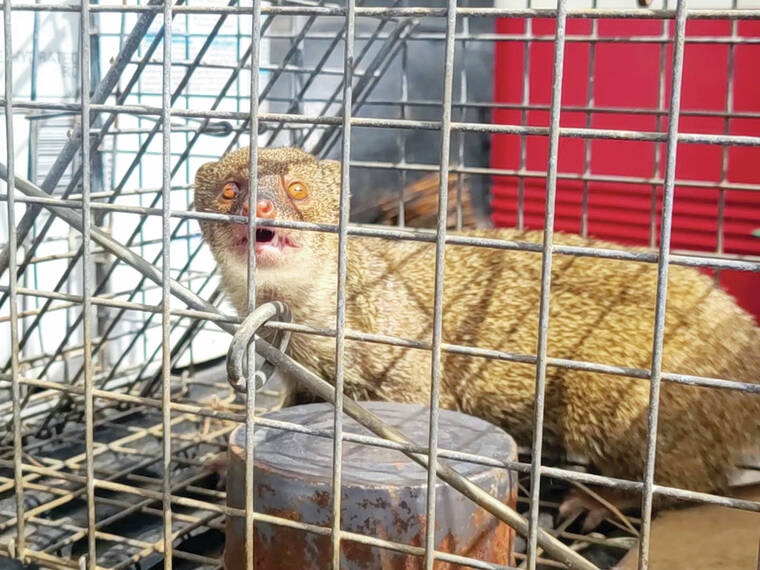LIHU‘E — A live mongoose was caught at Nawiliwili Harbor last week, renewing concerns over the possibility that the invasive species could spread to Kaua‘i.
Dockworkers first reported spotting a mongoose at the harbor on April 28. On May 1, state Department of Transportation employees corroborated the sighting after spotting a mongoose chasing a chicken through one of the harbor’s car lots.
Between May 1 and May 5, the Kaua‘i Invasive Species Committee and state Department of Health’s Vector Control Branch deployed 43 traps surrounding the harbor, one of which captured the mongoose on Friday morning.
KISC has since handed the mongoose over to the U.S. Department of Agriculture’s Wildlife Services for analysis.
A carnivorous mammal, mongooses pose a serious threat to many of Hawai‘i’s native endangered and threatened species, including plants, birds and honu. In particular, the eggs and hatchlings of ground-nesting seabirds and waterbirds, as well as those of
endangered sea turtles, make for easy targets for the mongoose.
“Imagine how much time, energy and money we’re putting into protecting endangered and threatened species,” said Shaya Honarvar, a biologist and director of the Pacific Cooperative Studies Unit at the University of Hawai‘i at Manoa. “And all it takes is one mongoose to come in and eat or destroy the nest.”
Native to India, mongooses were first introduced to Hawai‘i Island in 1883 via Jamaica in an unscientific attempt to control rats in sugarcane fields. The plan infamously failed, as mongooses are active during the day and sleep at night, whereas rats are nocturnal.
“It was a really poor decision,” said Daniel Rubinoff, plant and environmental protection sciences professor at the University of Hawai‘i at Manoa. “It was disastrous.”
Mongooses were subsequently introduced to Maui, Moloka‘i and O‘ahu, where stable populations still exist today.
And while no mongoose population has ever been found on Kaua‘i, several sightings have occurred in recent years.
In 2021, a mongoose was captured at Nawiliwili Harbor. In 2016, one was trapped in the cargo area at Lihu‘e Airport. And in 2012, two mongooses were trapped in separate incidents — one at Nawiliwili Harbor and another near a resort in Lihu‘e.
“They are excellent hitchhikers,” said KISC manager Tiffany Keanini. “They come from cargo from infested areas on other islands, whether that cargo is coming in the harbor or if that’s coming in as air cargo.”
Although mongoose populations have yet to form on Kaua‘i, experts say their widespread prevalence on neighboring islands means continued vigilance is necessary to keep them from establishing a permanent Kaua‘i colony.
“If we start to hear regular mongoose sightings away from ports, then we’d have a problem,” Rubinoff said. “But I think it’s unrealistic to expect them to never pop up on Kaua‘i.”
The state Department of Agriculture urges residents to report suspected invasive species to the state’s toll-free pest hotline at 808-643-7378.
•••
Jackson Healy, reporter, can be reached at 808-647-4966 or jhealy@thegardenisland.com.


